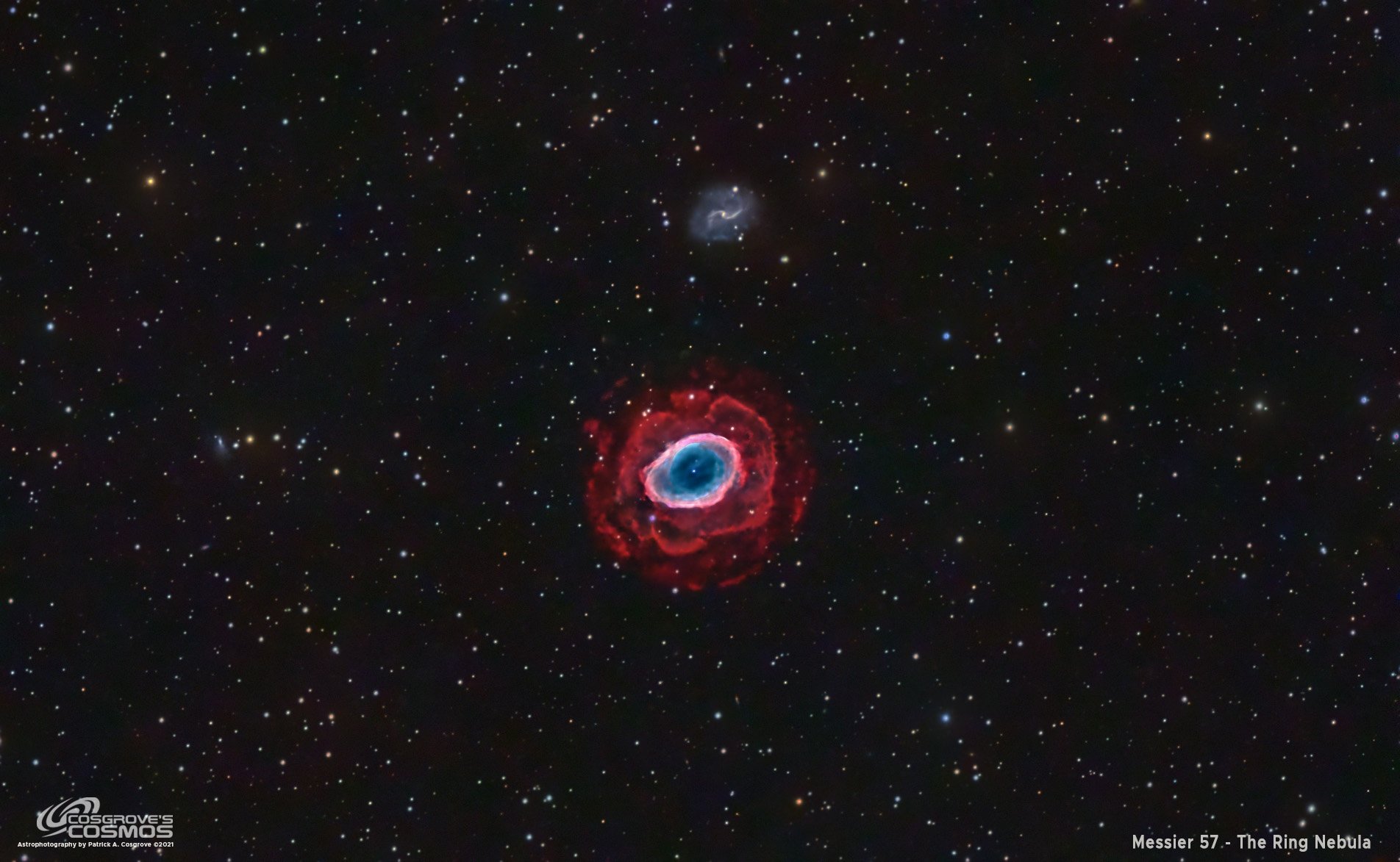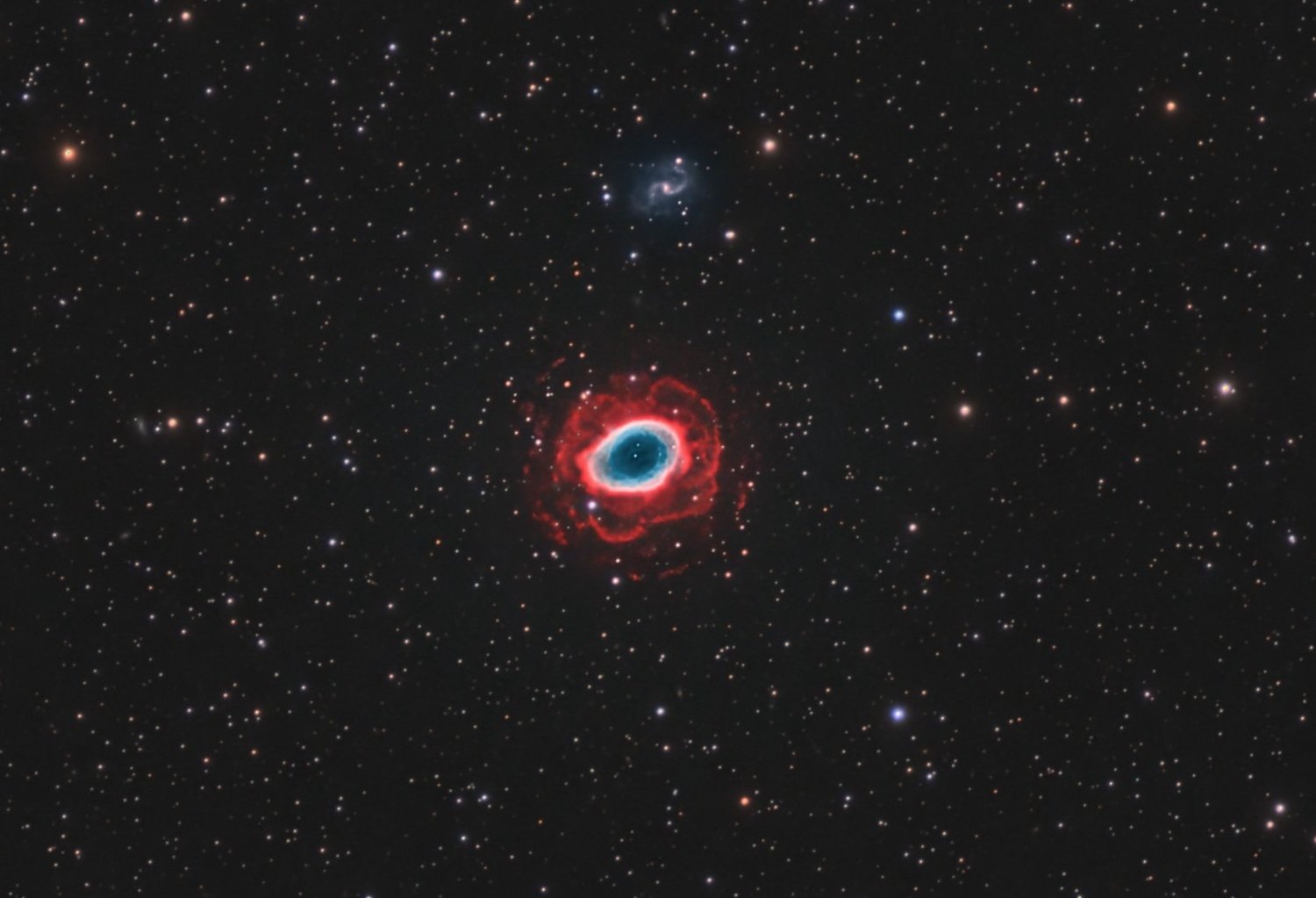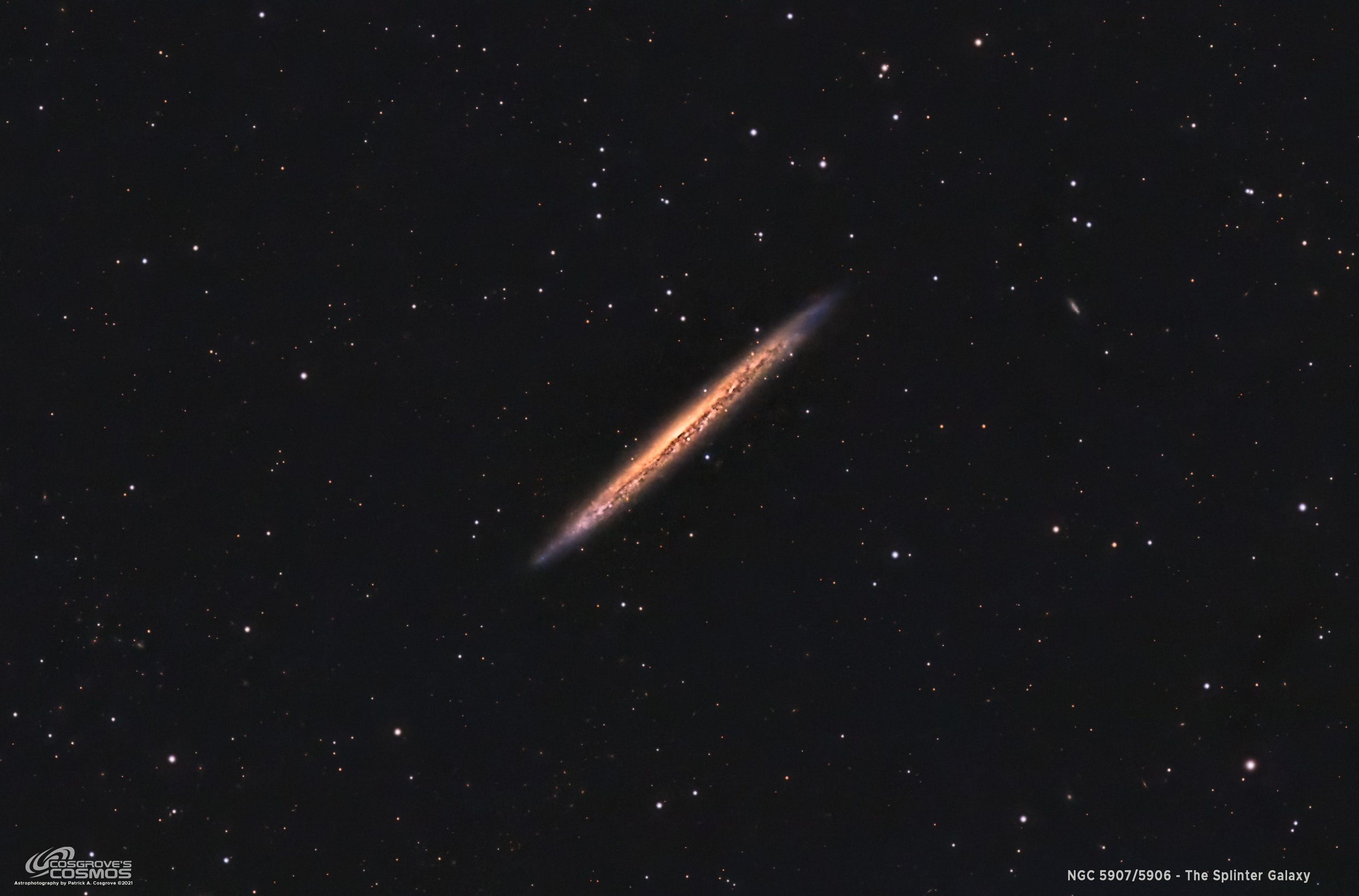Imaging Projects
In this blog, I will share the results of all of my imaging projects. The newest will be at the top and the oldest will be further down the stack. Going back in time here is interesting - some of my early stuff was pretty rough - but I did not see it that way at the time - I was thrilled to get anything back that looked like an image! Hopefully, you will see how my work has progressed with time!

Stephan’s Quintet – HCG 92 / Arp 319 Compact Galaxy Group - 24 Hours of LRGB!
Stephan’s Quintet is a compact group of galaxies in Pegasus caught in the middle of a slow-motion cosmic collision – four true members being stretched, stripped, and reshaped by gravity while a fifth foreground spiral simply photobombs the scene. This deep LRGB image reveals distorted spiral arms, long tidal tails, and the bright cores of galaxies that are gradually merging into a single massive system hundreds of millions of light-years away.

NGC 7331 and the Deer Lick Group with Supernova SN2025rbs (4.7 hours in LRGB)
While on a multi-night streak of capturing subs on my Sharpstar SCA 260 Galaxy scope, I retasked one night of shooting to try and get an image of NGC 7331 while Supernova SN2025rbs was still visible.

The Coma Cluster of Galaxies (Abell 1566) - Zoom In! 1000 Galaxies, 320M Light-Years Away! (~8.2 Hours of LRGB)
This is not just some star cluster! This image shows an immense cluster of over 1000 galaxies that are on average 320 million light-years away!
This image was the result of 8.2 hours of LRGB exposure taken on my William Optics platform from data collection during the first light of my Whispering Skies Observatory!

The NGC 5364 Group in Virgo - 6.3 Hours of LRGB
The NGC 5364 Group is part of the vast Virgo Cluster of Galaxies and showcase a mix of galay morphologies in one frame.
This shot was the very first from my AP130 platform after it had been installed in my new observatory.

Markarian’s Chain - A Famous Galaxy Cluster with 4.6 hours LRGB
Markarian’s Chain is a group of galaxies 50M light-years away moving together through space.
This image results from 4.6 hours of LRGB exposure from my FRA400 scope. This is the first image from this scope since it was moved to the new observatory!

Messier 106 - First Light for The Sharpstar SCA260 V2! (10 hours in LHaRGB)
The first light for both my new Whispering Skies Observatory and my new Galaxy scope, the Sharpstar SCA260 V2!
This is M106 shot in HaLRGB with 10 hours and 7 minutes of integration!

Reprocessing Project: Messier 31 - The Andromeda Galaxy (6 hours in LHaRGB)
This version of M31, taken in November 2021, is my favorite. But it has been a few years since I first captured and processed this data. I have learned a lot since then, and I also have some excellent new processing tools at my disposal, so I wanted to see where I would end up if I were to start from scratch with the data, and this is the result!
Let me know what you think of this new image!

Messier 101 Supernova SN2023ixf ~3 Hrs in LRGB - Yet Another Supernova Shot - But This One Is Mine!
With the recent discovery of a bright supernova in the well-known Messier 101 - The Pinwheel Galaxy - a lot of astrophotographers have been going out of their way to grab an image of this galaxy during this event.
As a result, there are many - probably TOO many - images of this going around.
So why take an image myself? Is it because I think I can do better? NOPE! After all, I shot this on a widefield scope not suitable for galaxies, and I ended up shooting through smoke and with too little integration. So why do it?
Well - I wanted my own image of this event- and I wanted an excuse to explore what supernovae really are - after all - here I am looking at one!
So this posting will delve into this topic….

Messier 102 - The Spindle Galaxy - 2.0 Hrs in LRGB - Still Shooting Through the Smoke…
Messier 102, also known as NGC 5866 and the Spindle Galaxy, is located 50 Million light-years away in the constellation of Draco. Its diameter is 60,000 light-years, making it 2/3rds the size of our Milkyway even though it has about the same mass.
NGC 5866 is one of the two galaxies known as the Spindle Galaxy. The other, NGC 3115, is an edge-on lenticular galaxy located in the constellation Serpens.
This was another image from the lul in the smoke plumes from Alberta. Because of this, this image was starved for integration time and shot through some smoke still in the sky - so this image is not as good as I would like it to be. But - if you zoom in, you can see a lot of detail in the galaxy's dust lane!

Messier 104 - The Sombrero Galaxy - 1.7 Hrs in LRGB - Too Little Time, Too Low in the Sky, Too Much Smoke…
Messier 104, also known as the Sombrero Galaxy, is a stunning sight in the night sky. Located in the constellation Virgo, this galaxy stands out due to its unique shape. With a bright central bulge surrounded by a flat disk of stars, it resembles a sombrero hat. It is estimated to be approximately 28 million light-years away from Earth and spans about 94,000 light-years across.
I have always wanted to shoot this target, but this project produced a result far below what I was shooting for as conditions were poor (smoke plumes), and integration ended up being a ridiculous 1.7 hours!
Surprisingly the resulting image is not that bad. It's not good, either.
It did better than expected because of its capable Camera. But at least I have a baseline for when I shoot this target again n the future!

Messier 97 - The Owl Nebula and Messier 108 - The Surfboard Galaxy - 4 hours LRGB
This imaging project captures two messier objects in the same field of view!
Messier 97 is a planetary nebula better known as the Owl Nebula.
Messier 108 is better known as the Surfboard Galaxy.
This image resulted from just under 4 hours of LRGB exposure. It was shot on my William Optics 132mm Plaform after being upgraded with a flattened/0.8X Reducer and a new ZWO ASI12600MM-Pro camera.
This image was the first project I have been able to do in 2023 and was taken on two nights when the Jet Stream pushed the Smoke Plume from the Alberta Wildfires to the south of us. But this image still suffered from smoke effects!

Messier 57 - A Reprocess of The Ring Nebula - 14.7 hours in LHaRGB!
Messier 57, the Ring Nebula has long been a visual favorite of mine. This was a reprocess of data that was collected in 2022. Based on 14.7 hours of HaLRGB, this data showed the rarely seen outer shell. I wanted to see if I could improve on that image with advanced tools and techniques. Since the original image was published, I created a new imaging project for posting to contain both the old and the new versions in the collection.

Messier 57 - The Ring Nebula - 14.7 hours in LHaRGB - Capturing the Outer Ring!
Messier 57, the Ring Nebula has long been a visual favorite of mine. It is also a target that I have shot two times before with poor results due to its small size. This time I wanted to try to do the best job I could, given the limitations of my current gear. I also wanted to get a really long integration. Finally, I wanted to add Ha data in an attempt to capture the red outer gas rings that are not seen visually and often not seen in the typical amateur images. While I ran into problems on the way, did pretty well in meeting my goals. See the full post for the entire story!

Messier 106 Region - 5.7 hours LRGB
Messier 106 is a galaxy in Canes Venatici, located 20-25 million light-years away.
Galaxy Season is challenging time to find targets when you are dealing with a widefield telescope. I finally decided to image the region around M106 as it contains a host smaller galaxies.
This is a 5.6 hour integration in LRGB using my Askar FRA400 Astrograph and the ZWO ASI1600MM-Pro camera.

Messier 64 - The Black Eye Galaxy - 2.6 hrs in LRGB
Messier 64 - The Black Eye Galaxy is the result of 2.6 hours of LRGB data taken with my William Optics 132 mm platform and the ASI1600MM-Pro mono camera. This famous galaxy is located 17 million light-years away in the constellation of Coma Berenices. This is my second attempt with this target - the first being taken two years ago. I am pretty happy with the new results!

NGC 5907/5906 - The Splinter Galaxy - 8 hrs in LRGB
NGC 5907 -The Splinter Galaxy - is another example of an edge-on Spiral galaxy that displays significant dust lane detail across its middle. Its located 54.5 million Light years away in the constellation of Draco. This was shot with my Astro-Physics 130mm with the ASI2600MM-Pro camera. 8 hours of integration in LRGB. It was a real challenge to pull out the details from this very small galaxy.

Messier 81/82 Wide Field: 3.5 hours LRGB - A Failed Quest for IFN!
I decided to try using my widefield Askar FRA400 platform to image the region around M81 & M82 to try and capture IFN (integrated Flux Nebula). This effort failed miserably! The resulting image was not too bad, but I was not able to get the kind of integration needed to capture this elusive feature! While this was a major disappointment, the resulting image shows M81, M82, and a third small galaxy NGC 3077 in a very nice part of the sky.

NGC 4565 - The Needle Galaxy - 11.5 hours in LRGB
NGC 4565, The “Needle Galaxy” is a classic example of an edge-on spiral galaxy. This is one of my favorite galaxies and I was very happy to finally have the chance to shoot this target! This was the result of 11.5 hours of LRGB data integration taken with the Williams Optics 132mm FLT APO scope, the CEM60 mount, and the ASI1600MM-Pro camera.

M101 - The Pinwheel Galaxy in LHaRGB (11 hours)- a third attempt!
My third attempt shooting Messier 101 - the Pinwheel Galaxy. My first was in 2020 using an OSC camera and a two-hour exposure. Not bad for a first attempt. My second was in 2021 using an ASI1600MM-Prop mono camera. 15-hour integration! However many data problems and a very poor final results. This time around I am using my Astro-Physics 130mm with the ASI2600MM-Pro camera. 11 hours of integration in LHaRGB.

Messier 31 - The Andromeda Galaxy in LHaRGB - 6 hours
This is my third attempt at M31. This time with a widefield system that can fit the entire galaxy into the field of view., and a mono camera that allowed me to collect Ha as well as LRGB data. A total of 6 hours of data integration.
Messier 31 is also known as NGC 224 and the Andromeda Galaxy, or as the Andromeda Nebula before we knew what galaxies were. It can be seen by the naked eye in the constellation Andromeda (how appropriate!) and is our closest galactic neighbor located 2.5 Million light-years away. It is estimated that it contains about one trillion stars - twice that of our own Milky Way.
